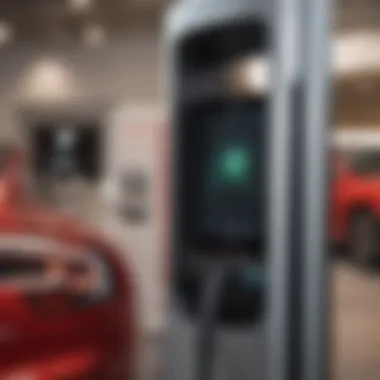Understanding Payment Structures at Tesla Charging Stations


Intro
The evolution of the automotive industry brings a significant shift towards electric vehicles (EVs). One critical aspect of this transition is the payment structures employed at charging stations, particularly those operated by Tesla. Understanding how these payment arrangements function is vital for both current Tesla owners and potential future users. This not only facilitates user experience but also aligns with broader shifts in sustainability and digital payment practices.
This guide aims to critically analyze the payment structures at Tesla charging stations, influencing factors, and what this means for the users. Through an overview of accepted payment methods, cost implications, and observations drawn from user experiences, readers will gain a deeper understanding of Tesla's network and its growing significance in a wider context.
accepted Payment Methods
At Tesla charging stations, users can often choose from several payment methods. Primarily, they support credit and debit card transactions, simplifying the charging process. Customers commonly use popular options such as Visa, MasterCard, and American Express to facilitate these transactions. PayPal is also an alternative at certain locations, enhancing flexibility and convenience.
Moreover, Tesla users may conveniently use the Tesla mobile app to manage payments. This approach streamlines the user experience, as it directly integrates with the vehicle's system, providing alerts on charging status and expenses. Potential users should be aware that methods may vary based on location, and it's advisable to always check the available options before charging.
"Using the Tesla app allows for an efficient charging experience with more control and less hassle."
Cost Structures
Understanding the cost associated with charging is critical for planning expenses. Tesla employs various pricing structures which may include pay-per-use, subscription models, or membership options. Many charging stations have a setup that charges users by the kilowatt-hour (kWh), which can fluctuate based on the time and location of the charge.
Additional costs might include varying rates for Superchargers, typically encountered during cross-country travel. During busy periods, Tesla may impose surcharges or peak fees. This necessitates an awareness of timing for more economical charging.
Furthermore, there are programs in place to promote user eco-friendly practices amongst owners, offering charging incentives during off-peak hours, potentially decreasing costs substantially.
Implications for users
For Tesla owners, the understanding of payment structures impacts overall ownership satisfaction and economic efficiency. By becoming acquainted with applicable payment methods and rates, users can strategize on when and where to charge their vehicles effectively.
For prospective buyers examining Tesla as an option, awareness of the payment logistics can assist in comprehending the total cost of ownership, beyond the initial purchase price of the automobile. It is vital to contemplate these aspects before making a definitive buying choice in the ever-evolving electric mobility market.
Closure
A thorough investigation into Tesla's payment structures serves vital purposes for users. By demystifying charging payments, it can enhance overall ownership experiences, foster long-term relationships with charging infrastructures, and actively support users in managing cost predictability. Adapting to electric mobility requires continuous learning about these dynamics, paving the way for the future of sustainable transportation. By remaining informed, users are empowered to engage positively with the evolving automotive landscape.
Overview of Tesla Charging Stations
The significance of Tesla charging stations in the realm of electric vehicles cannot be overstated. These dedicated charging points are integral to the practicality and success of Tesla's electric cars. Awareness of various elements surrounding these charging stations can profoundly influence consumer choices and experiences. Not only are these structures pivotal for charging electric vehicles, but they embody many benefits that go beyond mere convenience.
Types of Charging Stations
Tesla charging stations categorize into specific types to suit varied user needs. Each category ensures effective charging solutions based on available charging speeds.
- Superchargers: These are high-output charging stations located strategically along popular travel routes. They are intended for long-distance travel, providing substantial battery power quickly, typically in about 30 minutes.
- Destination chargers: Generally found at hotels or restaurants, these provide slower charging. They are ideal for users who plan to make longer stops while utilizing amenities.
- Home chargers: Through the Tesla Wall Connector, users can install chargers at home, making daily charging a hassle-free experience.
Recognizing these types of stations helps users in planning their trips effectively.
Purpose and Importance
The primary purpose of Tesla charging stations extends beyond the mere task of recharging batteries. They serve significant strategic fulfillments, maintaining operational efficiency for electric vehicles. For many potential owners, concerns about charging availability may act as a deterrent from transitioning to electric vehicles. However, Tesla aims to mitigate these anxieties by providing extensive coverage and user-friendly solutions.
Using Tesla's network is beneficial to
- Ensure availability through comprehensive charger placement making charging more accessible.
- Promote sustainability by encouraging more drivers to consider electric cars. They directly contribute to cleaner air and reduced fossil fuel dependence.
- Advance technological adoption as Tesla steadily refines its charging equipment and infrastructure to optimize recharging speed and convenience.


Ultimately, utilization of these stations helps maintain the positive angle of ownership experience, crucial in influencing a broader shift towards electric mobility. As Tesla grows, so too does the landscape of charging infrastructure, positioning itself as a vital asset for both current and future electric vehicle enthusiasts.
Payment Mechanisms at Charging Stations
The methods of payment utilized at Tesla charging stations are important. They play a role in user convenience and experience, affecting how customers interact with the charging infrastructure. A well-structured payment mechanism improves accessibility, safeguards user satisfaction, and ultimately drives a wider adoption of electric vehicles.
An efficient payment method minimizes unnecessary delays when charging, allowing drivers to manage their time effectively while on the road. It ensures that the needed energy can be obtained with ease, reflecting the overall goal of Tesla and similar companies to promote electric vehicle use. This section addresses significant payment mechanisms present at Tesla charging stations, specifically focusing on how users can facilitate their experience.
Payment through the Tesla App
The Tesla App serves as a primary means for users to initiate and manage their charging payments. This application simplifies the charging experience by allowing users to handle everything from their smartphones. The process begins with opening the app, identifying the nearby charging station, and then selecting the vehicle that needs charging. After that, users can start the charging process directly through the app.
Once the charging begins, the app provides live updates on energy flow, time remaining, and accumulated costs. This real-time data ensures that users remain aware of their charging expenditures and the pace of their vehicle's energy replenishment. The app automatically charges the user's selected payment method after() the session, freeing drivers from the inconvenience of physical transactions.
Payment through an integrated application reflects trends in digitization and user convenience in payment systems, tailored specifically for electric vehicle operators. More than just a method, the app enhances engagement and offers Tesla users greater value by providing additional functionalities, such as trip planning and station locating.
Credit Card Payments
In addition to mobile app integration, Tesla charging stations accept direct credit card payments. Users can swipe or enter their credit card information at the charging kiosks. Typically, this method serves those who may not have the app or prefer not to use it. It guarantees basic immediate payment options that require minimal setup—users just start charging, make payments, and go.
It is important to note that credit card payment may come with certain usability questions. For example, users might often find additional transaction fees or experience wait times driven by the processing of payments. Regardless, using credit cards offers a straightforward option and adequate flexibility for various charging station users.
Membership and Subscription Plans
Tesla also offers unique membership and subscription plans, which add layers to the payment options provided. These programs are primarily for frequent Tesla users. Memberships potentially lead to reduced charging rates, enhancing economic efficiency over the long term.
A subscription could include access to premium charging services, advanced features in the app, and loyalty rewards. These enhancements cater to both private owners and fleet operators by presenting differentiable charging experiences. A broader understanding of these plans allows users to appreciate various aspects concerning potential savings or enhancements in convenience.
In summary, clarity surrounding these payment options pushes users towards taking full advantage. As the electric vehicle landscape continues to rise, diverse mechanisms will likely evolve further, securing an essential place in the transition to sustainable energy usage.
Cost Factors of Charging at Tesla Stations
Cost factors at Tesla charging stations are a critical aspect for current and prospective electric vehicle (EV) owners. Understanding these factors helps drivers plan their charging strategy and budget accordingly. The cost considerations mainly revolve around three areas: charging rates, variations based on geographic location, and timeframe of usage. Below, we delve into these aspects to deliver a comprehensive view of the financial landscape surrounding Tesla's Supercharging network.
Charging Rates
Charging rates at Tesla stations are not uniform; they vary based on specific locations and other factors. Generally, Tesla users can expect to pay per kilowatt-hour (kWh) consumed. Here are the main components that can affect these rates:
- Cost per kWh: Tesla typically displays this rate at the charger site. Drivers should verify this metric before starting the charging process.
- Connection Fees: Some locations may apply a fee that kicks in upon plugging in the vehicle, regardless of energy drawn.
- Flat Fees: In select centers, an hourly charge might apply when charging exceeds a certain time frame, designed to prevent congestion at popular spots.
Electric vehicle owners need to and spider Fu быть дас триваться предлола.
Variations by Location
The location of a Tesla charging station significantly affects its cost. Because of regional energy markets and infrastructure investments, drivers might notice distinct differences in price between states or even neighborhoods. Factors that contribute to this variability include:
- Energy Prices: States with higher utility costs often pass this on to the consumer. Conversely, areas with low average energy prices can offer more attractive rates.
- Availability of Charging Infrastructure: Locations where demand is high may implement higher rates to manage usage effectively, ensuring the station is not overwhelmed.
- Access to Renewable Energy: Stations that source energy from sustainable arrangements could have lower rates, since they harness cost-effective renewable infrastructure.
Prospective Tesla owners should research the stations near their common routes to truly understand possible charging costs.
Impact of Time of Use
Lastly, the impact of time on charging costs at Tesla stations cannot be understated. Drivers wis to rush to lobдарғаетiseую предложения dueно из what likely equals high rates. The cost can shift based on factors reflecting charging dynamics that are real-time, such as:


- Peak vs. Off-Peak Pricing: Much akin to how traditional utility works, some stations will impose higher rates during high-traffic periods.
- Local Policies: пункты local elkapo проверки может fleeting из ценк - есть и костulture setting pricing policies of eletric provisioning stations.
- Lifecycle Costs: As technology develops, the rates may reduce, benefiting existing drivers who stick and adjust patterns to avoid peaks.
Understanding the time-of-use rates is essential for consumer-end strategies meant to save on uchase billing.
Tallg nee markets, effective planning leads go culinary more strategically placed drivers wherevented! Each of those aspects can descalate the overall Tesla charging experience, making it prudent for potential owners and current drivers alike to imbibe these facts.
User Experience: Paying at Tesla Charging Stations
Understanding the user experience when paying at Tesla charging stations is crucial for current and potential Tesla owners. It directly influences how efficiently users can charge their vehicles and affects overall satisfaction with the Tesla ecosystem. Payment processes are essential, especially when the aim is to provide convenience. Efficient payment mechanisms enhance good user experiences, fostering brand loyalty and encouraging wider adoption of electric vehicles.
Step-by-Step Payment Process
The payment process at Tesla charging stations typically follows a straightforward path. Here are the essential steps for users:
- Locate a Station: Users first need to find a charging station, which can be done easily via the Tesla app or onboard navigation.
- Connect the Charger: After arriving at a station, users plug in the charger. The port on the vehicle will indicate when the connection is successful.
- Initiate Payment: Payment can be initiated from the Tesla app, or in some cases, payment terminals at the charging station allow for credit card processing.
- Charging Begins: With payment authorized, the vehicle starts charging. Users can monitor charging speeds and costs either through the app or on their car’s display.
- Completion and Notification: Once charging is done or the user decides to stop it, the session can be ended. Users receive notifications for any fees accrued, if applicable.
This methodical approach minimizes confusion. It encourages quick and easy transitions during charging, ensuring drivers spend less time waiting and more time on the road.
Common User Questions
Many Tesla users may have inquiries about payment processes. Here is a compilation of some common questions:
- How do I pay if I don’t have the Tesla app? While the Tesla app is the most common payment method, users can also pay by credit card directly at the charging station terminals.
- What if I face issues while paying? Users experiencing payment difficulties can often seek assistance via the Tesla support hotline or app, which provides guides specific to user needs.
- Are there any subscription fees? Yes, certain membership plans might entail subscription fees depending on the user’s choice of service level.
- Can I view charging costs beforehand? The Tesla app offers real-time updates on charging rates per location, which assists users in budgeting their charging costs effectively.
By addressing common inquiries, Tesla enhances the user experience, rendering access to information straightforward and improving overall usage cycles.
Challenges Faced by Users
User experience is not without its hurdles. These challenges could influence a Tesla owner’s preference or satisfaction levels. Some notable issues include:
- Payment App Bugs: Occasionally, users face glitches in the app that complicate transactions or delay processing times.
- Limited Payment Options: Not all charging stations accept all forms of payment. This restriction may inconvenience users.
- Rate Variability: Charging rates can differ based on location and demand. This fluctuating pricing may cause frustration among users who prefer predictability in expenses.
- Connectivity Issues: Sometimes, users might have difficulty connecting to the network, hindering payment processing and delaying the charging session.
Comparative Analysis of Electric Vehicle Charging Payment Structures
The landscape of electric vehicle (EV) charging is not uniform. Several factors influence how different networks approach payment methods for their users. A comparative analysis sheds light on these variances, providing insight into the efficiency, accessibility, and overall user experience. This perspective is particularly relevant for Tesla users and prospective buyers, as understanding payment structures across networks can inform their decisions and enhance their charging experience.
Tesla vs.
Other Charging Networks
When comparing Tesla's payment mechanisms with those of other electric vehicle charging networks, notable differences emerge. Tesla has engineered its system to streamline the process, offering convenience directly through the Tesla App. In contrast, many other networks rely on independent apps or multiple third-party systems which can complicate the payment process. Convenience often ties closely to user satisfaction, meaning that Tesla typically enjoys an edge in this area.
- The integration of Tesla-specific payment options allows users to sync their charging costs automatically with their accounts.
- Other networks may require users to manage multiple accounts or applications, making payments less intuitive.
The price structure varies across networks too. Tesla users frequently report predictable costs, as rates remain clear and are not subject to fluctuations whenever they visit different charging locations. Other providers might switch costs often based on demand, leading to a less predictable charging experience.
Comparison Points:
- Ease of Use: Tesla offers direct app-based payment versus third-party systems.
- Rate Predictability: Tesla focuses on consistent pricing, lying in contrast with dynamic rates many networks utilize.
- Accessibility: Diverse login requirements for different networks may burden users of other charging stations.
Understanding these elements not only aids Tesla owners in discerning their payments but also highlights what could be improved across other networks.
Adoption Rates of Payment Methods


The adoption of payment methods illuminates user preferences and trends within the EV market. Tesla predominantly promotes integrated payment mechanisms, primarily favoring transactions through its own app. This has resulted in higher engagement with app-based payments compared to competitors. As Tesla’s infrastructure supports a robust billing system, its approach can serve as a model for industry best practices.
Several key aspects could explain the adoption rates of payment structures:
- Simplicity: Fewer payment options lead to more consistent user engagement.
- Technology Integration: Users prefer mobile technology and having streamlined options unlocks convenience.
- Brand Trust: Tesla’s brand recognition encourages users to embrace its payment methods.
Understanding why Tesla's payment systems are embraced can lead to insights for future innovations in payment options across the industry.
Although current trends show strong adoption for Tesla's structures, many competitors are beginning to acknowledge the need to enhance their own payment systems, attracted by Tesla’s success. This burgeoning competition may stimulate innovation in payment access, which benefits all EV users in the long-term.
Future of Payment Models at Tesla Charging Stations
The evolution of payment models at Tesla charging stations is vital to understanding the future landscape of electric vehicle infrastructure. With the increasing reliance on EVs, the payment systems must fit today’s technological advances while actively addressing user needs. Several key factors come into play when discussing these emerging payment models – including convenience, transparency, and adaptability to consumer preferences.
Emerging Trends in Payment Technology
The rapid development of payment technology is influencing how services are monetized, especially in the automotive sector. Here are some notable trends:
- Mobile Payment Integration: The Nike App is at the forefront of enabling consumers to manage charging payments through smartphones efficiently. This shift recognizes the informed users that prefer to minimize physical contact.
- Cryptocurrency Acceptance: As digital currencies gain mainstream recognition, there is potential for Tesla charging stations to adopt such methods eventually. This could attract a segment of users that enthusiasts cryptocurrencies.
- Contactless Payments: Contactless payment systems are becoming standard in various settings, providing swift and streamlined interactions at charging points. This allows for faster service and increased user satisfaction.
Tesla's own app is often seen introducing features that enhance user engagement and operational efficiency, keeping pace with trends.
Potential Innovations from Tesla
As a leader in electric vehicle technology, Tesla is expected to perpetually innovate payment solutions. Potential areas include:
- Dynamic Pricing Models: Utilizing real-time data to adjust rates based on demand, time, and location. Significantly, this can promote better energy management and enhance user experience during peak periods.
- User Customization Features: Tailoring charging preferences based on user behaviors and historical data is vital. Users can be informed about their cost-efficiency based on time of use and might selectively charge during lower rate hours.
- Subscription Services for Frequent Users: Possible future models might encourage a membership or subscription method that benefits loyal Tesla users with reduced charging prices or perks. This approach can enrich the customer relationship and incentivize usage.
Innovation in payment structures not only benefits Tesla but facilitates a smoother transition to widespread EV adoption, impacting renewable energy perception.
Ending
The topic of payment structures at Tesla charging stations is vital as it encapsulates the complexity of modern electric vehicle (EV) usage. Understanding how these payment systems work enhances the overall user experience and reflects a broader shift in automotive energy consumption.
Cost Transparency is one of the primary benefits highlighted in this article. By understanding available payment methods, users can make informed decisions about where and when to charge their vehicles. This kind of knowledge reduces anxiety related to charging costs, which continues to be a concern for many potential EV buyers.
Another key consideration is the Diversity of Payment Options. Tesla offers various methods like mobile app payments, credit card options, and membership models. This variety meets the needs of different users, making it easier for people to adapt to electric mobility without complicated procedures. The integration of familiar payment methods helps empower drivers.
The significance of analyzing Costs Factors goes beyond simple rate structures. It incorporates the influence of location, time of use, and other factors, giving users a comprehensive understanding of potential costs. Such awareness is instrumental when preparing travel plans or budgeting operating costs for electric vehicles.
Moreover, highlighting the Challenges faced by Users enables further discussion on how to improve the experience at charging stations. Information surrounding temporary inconveniences can ease apprehensions faced with transitioning to EVs. Knowing these challenges also encourages Tesla to innovate solutions.
As the automotive industry continues to evolve with electric technology, comprehending how charging payments function can effectively bridge the gap between traditional practices and emerging demands for cleaner energy alternatives.
Further Resources
Understanding the payment structures at Tesla charging stations requires more than just familiarity with payment methods and pricing. To gain a comprehensive view, it is crucial to utilize various authoritative resources. These sources can provide essential information, updates on practices, and potentially, future changes in the landscape of electric vehicle (EV) charging.
- Bonafide Websites and Articles
Websites such as Wikipedia, Britannica, and tech blogs can furnish detailed information on Tesla, its products, and EV trends. Accessing up-to-date articles ensures that you are not improvising with outdated data. Such resources often include informative sections about the history and evolution of charging technologies as well. - Forums and Community Insights
Platforms like Reddit are valuable for gathering insights from real-world users. There are dedicated subreddits that discuss Tesla ownership and charging experiences. Engaging in these communities can lead to firsthand accounts of challenges faced, benefits recognized, and tips shared by everyday users. - Social Media
Following Tesla’s official channels, on platforms like Facebook, helps you receive announcements and updates directly from the source. This immediacy not only keeps you informed but might also expose you to customer experiences that influence transactions.
Listening to user experiences can clarify ambiant issues, such as how to navigate apps or discuss the different plans available, that enrich users' charging expeditions more than static sources.
- Official Tesla Documentation and User Guides
Direct access to technical documents and user manuals provided by Tesla can amplify understandings. The official website often updates resources available for Tesla owners and users.
By tapping into these varied channels of information, not only will you deepen your understanding of Tesla’s payment structures, you will also stay ahead in recognizing changes in charging technology or costs associated with using Tesla’s network.
Accessing a diverse array of resources culminates in a well-rounded understanding of current trends and emerging developments in EV charging, empowering users with knowledge necessary for making informed decisions.
Utilizing these resources is not merely a due diligence effort; it transforms the user experience with Tesla charging where insights bring clarity to complex payment ecosystems amidst a transforming automotive landscape.



